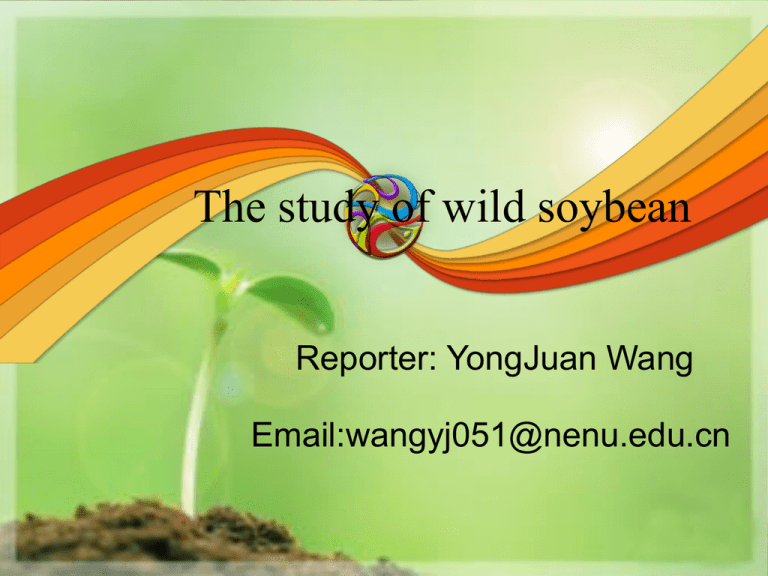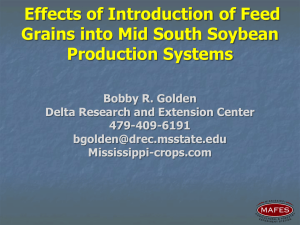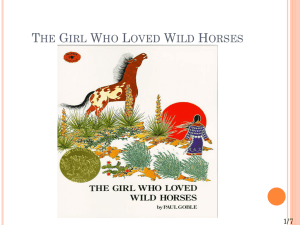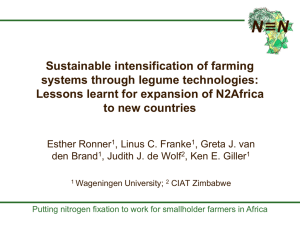The introduce of wild soybean
advertisement

The study of wild soybean Reporter: YongJuan Wang Email:wangyj051@nenu.edu.cn The introduce of wild soybean • Wild soybean (Gkycine soja) is the wild relative species of cultivated soybean (Glycine max), and its geographical distribution is only limited to the middle and northern East Asia, including China, Korea, Japan and Far-east Russia. • Recent years, scientists in China have studied wild soybean from different subjects, including ecology, structural botany, physiology, seed chemistry, plant protection, genetic and breeding, population ecology, pollen structure, molecular biology and soybean origination, evolution etc. • We will invested the distribution, habits, seed quality and physiological characters of wild soybean. content One. the distribution of wild soybean Two. Habitats of wild soybean Three. The seed quality of wild soybean in China Four. physiological characters of wild soybean One. Characteristics of geographical distribution of wild soybean and its larger populations • • • Wild soybean was spread widely in China, except Qinghai, Xinjiang and Hainan three province have not found the wild soybean, other province has its footmark. northward to Huma county in Heilongjiang province (53° N), southward to Xiangzhou in Guangxi province (24°N) and Yingde in Guangdong province (24°10` N ), east to Fuyuan county in Heilongjiang province (134°20`E), otherwise Tibet is the end to west. In the vertical, 1,300 km height was the upper limit in Northeast China, but in Tibet they were found below 2,250 km height. Meanwhile, the distribution of wild soybean is influenced by topography and landforms, from the east of Daxing`anling Mountain Range, Inner Mongolia Plateau, Qinghai-Tibet Plateau and Yunnan-Guizhou Plateau, the distribution of wild soybean was increased gradually. The size of population is effected by environment oscillation and human activities. The larger populations were found in the river side or wetlands in Yangtze River, Yellow River and Northeast China. Two. Habitats of wild soybean The environment factors that affect distribution and habitats of wild soybean is complex. Its distribution pattern announced that the key factors is temperature and Humidity, the Duration of sunshine affect its growth period. 1.The effects of temperature 2.The effects of light 3.The effects of precipitation 4.The requirements to soil conditions 5.The growth period of wild soybean 1.The effects of temperature Many aspects influenced by temperature. Growth of wild soybean need the suitable temperature conditions. The long term hot climate is bad to wild soybean. The suitable temperature is that the average temperature is higher than 20 degrees, and the different temperature between day and night should not be large. Otherwise, studies showed the place where the temperature of the warmest month is less than 20 degrees or the average monthly temperature is higher than 20 degrees more than six months can not find wild soybean. 2.The effects of light The effects of light to wild soybean is photoperiodism. The growth and developm ent of plants adapt to the local illumination time, so the day duration differernce of the first flowering between north and south of China is four hours,moreover the d ay duration is range from 13 hours to 17 hours. The lower latitude of the later flow ering. So the data of flowering will be more later when the plants are taken from s outh to north. 3.The effects of precipitation Precipitation is a key factor for wild soybean, moist soil is the best condition for them, even in the long-time water condition, the plants will be growth well with the help of associated plant. But the place where less than 300 mm of rainfall can not find wild soybean. 4.The requirements to soil conditions The requirements to soil conditions are not strict when the precipitation and temperature is suit for wild soybean. Research showed that under the pH 9.18~9.23 of the soil in Gaixian, Liaoning province, the wild soybean was growth well too. 5.The growth period of wild soybean There are differences among the geographical plant populations, owing to the climate variability. In China, the growth period of wild soybean is shorter with latitude increasing, but the shorter is occurred in the growing season, not in the flowering stage. For example, the plants in 50°N is flowering after sixty days after emergence, but the plants in 25°N is after 170 days. Three. The seed quality of wild soybean in China Wild soybean as oil crops, the protein and fat content is an important indicator of the evaluation of its quality. The study showed that: the protein content and amino acid composition of wild soybean is higher than cultivated soybean, but the fat content is relatively small. 1. protein content and amino acid composition of wild soybean. 2. fat content and fatty acid composition of wild soybean 1. protein content and amino acid composition of wild soybean. The study of 6172 wild soybeans showed that: the highest protein content is 55.70%, mean content is 44.9%. Wild soybean protein content is generally higher than cultivated soybean(42.15%). Jilin province is one of the highest protein content area. (1)Geographical distribution of protein content Certain environmental conditions will be bred some plants with related quality. Many studies have showed that: the protein content of wild soybean have the obvious geographical distribution law. Wild soybean protein contents have a significant difference in latitude distribution. In position, wild soybean has two high-protein regions: 30°~32°N and the area of 43°N. But at the same area, higher altitudes of plant material protein content is lower than the material of the low-lying areas. All in all, from south to north the protein content changes trend as low – high – low – high. At the same latitudes, from west to east has a decreasing trend and presents the distribution of N-shaped. (2)Relationships between protein contents and the main biological characters • Studies have shown that: the protein content of wild soybean is high in which has a low evolutional level and a typical wild shape. • The seed coat colors of wild soybean have a certain impact on the protein content, the protein content of the cyan kinds of skin is high, black followed by, two-color and brown is the lowest. • Protein content of purple flower wild soybean is higher than white flower plants. protein content of brown hair wild soybean is higher than grey hair plant. • The high temperature is conducive to the accumulation of protein, especially the late period of protein formation and accumulation is easier affected by temperature. (3)Amino acid composition of wild soybean Soy protein contains many amino acids, and the balance on the amino acid composition is better than other crops. But the studies showed that the highest content is glutamic acid, the content of cysteine and methionine is the lowest. So the lower content of sulfur-containing amino acids is the limiting factor affecting the nutritional value of soybean. 2.Fat content and fatty acid composition of wild soybean A study in 5200 wild soybean materials showed that: the fat content ranges from 5.1% to 20.2%, the mean content is 10.6%, moreover the wild soybean fat content is lower than the semi-wild soybean(15.43%) and cultivated soybean(19.12%). (1)Geographical distribution of fat content • Wild soybean fat content are quit difference due to the location in China. The trend of the fat content of wild soybean is higher in south than in north, the relationship between fat content and latitude showed a single summit, the high fat content zone distribute in the latitude of 34 ° ~39 ° N, the lower content is distribute in 26 ° ~28 ° N and 43 ° ~50°N. • The extremely significant negative correlation between the wild soybean fat content and longitude. From west to east, the fat content reduced from 12.5% in 97 ° E to 7.7% in 134 ° E, among those, the lower zone is mainly in Northeast China. • High altitudes have the lower temperature, the larger temperature difference between day and night, the stronger sunshine. All these are conducive to the fat formation. (2)Relationships between fat content and the main biological characters • The fat content of wild soybean and hundred seed weight showed a significant positive correlation, that is to say, the fat content increase with hundred seed weight increasing. • The wild soybean with light-colored seed coat, black hilum and obvious main stem have a the high content of fat. This because the main stem is conducive to the transportation and distribution of nutrients. • The relationship between fat content and the mean temperature during the growth of wild soybean is that the lower temperature conducive to accumulation of fat. This is like in the colder area, the animal have a greater volume. (3)Fatty acid composition of wild soybean • Wild soybean contains a variety of essential fatty acids, for example the oleic acid, linoleic acid, linolenic acid and so on. They are necessary to synthesize phospholipid, form the cell structure, maintain normal tissue function. • Wild soybean, semi-wild soybean and cultivated soybean is different in the content of fatty acid. Low oleic acid content and high linolenic acid content in wild soybean, but in contrast cultivated soybean. • There is closely relationship between the ingredient of the soybean fatty acids and the evolutionary of soybean. With the improvement in the level of evolution, Oleic acid content increased, the linolenic acid content decreased. Four. physiological characters of wild soybean 1. photosynthesis Photosynthesis of wild soybean absorb sunlight by photosynthetic pigment, and turn carbon dioxide and water into organic matter, also release oxygen . (1)photosynthetic rates of leaves of wild soybean many researches showed that: compared photosynthetic rate of wild soybean with cultivated soybean ,in vegetative stage wild soybean is higher than cultivated soybean, but in reproductive stage is lower. Its rational in the view of evolution, hundred-seed weight of wild soybean is only 3gram, semi-wild soybean is about 5-10g, and cultivated soybean is even more than 18g, so in reproductive stage the photosynthetic rate of wild soybean is lower than cultivated soybean. (2) characters of leaves and photosynthesis ①Chlorophyll content and photosynthetic rate chlorophyll content is related to photosynthetic rate, in a certain range, the higher of chlorophyll content ,the stronger of photosynthetic rate. Chlorophyll content of wild soybean is lower than cultivated soybean in unit leaf square, but is higher in fresh weight of unit leaf. moreover, wild soybean has more LHC, which makes it can use diffused light and weak light to accumulate photosynthetic products. It explains that wild soybean has the character of shade plant . ②Total nitrogen content of leaves and photosynthetic rate Nitrogen is the base matter of photosynthesis protein, so it is closely related to photosynthesis. In fruit stage, the total nitrogen content of leaves is highest. when the nitrogen content declines, the photosynthetic rate declines also. ③RuBP carboxylase activity and photosynthetic rate RuBP carboxylase is a key enzyme in carbon cycle of photosynthesis of C3 plant, its activities is a very important factor in photosynthetic rate. RuBP carboxylase activity is higher in branch stage than fruit stage. ④Specific leaf weight and photosynthetic rate Specific leaf weight means dry weight or fresh weight in unit leaf square, it indicate the thickness and density . Specific leaf weight of wild soybean has a declined trend from flowering stage to fruit stage. (3)effects of external conditions on photosynthetic rates ①The effects of light Light is the energy source of photosynthesis, with the increasing of light intensity , the photosynthetic rate of wild soybean will increase. When the light intensity increases to light saturation point, the photosynthetic rate would not be increased. Meanwhile, the ingredient of light could affect photosynthetic rate also, the photosynthetic rate is higher in red light than blue light. ②The effects of temperature Due to temperature could affect enzyme activity, so temperature could produce a great effect on photosynthetic rate. in the low temperature, enzymatic reaction will decline, further limit the photosynthesis. At a certain range of temperature, with the increasing of temperature ,the rate of enzymatic temperature will increase, the photosynthetic rate will relevant increase. But in high temperature, the photosynthetic rate has a declined trend, high temperature destroyed the structure of chlorophyll molecular and cytoplasm, made the enzyme passivation. Otherwise, high temperature could increase respiration ,so the apparent photosynthesis would decline. 2.Assimilation of nitrogen (1)Nitrogen resources and assimilation system Nitrogen sources of Wild soybean mainly have two: one is from soil, another is from fixation of nodule bacteria. Accordingly ,there are two nitrogen assimilation system, one pathway is root system of wild soybean absorb ammonium nitrogen and nitrate nitrogen from soil, with the help of nitrate reductase and nitrite reductase ,nitrate assimilation become ammonia, then produce protein; another pathway is that the nodule bacteria of wild soybean making nitrogen in the air become ammonia with the help of dinitrogenase . Then produce amide ,amino acid and ureide, the nitrogen of fixation mainly transport in the form of ureide. (2) Assimilation of nitrate and ammonia Nitrate is a form of inorganic nitrogen ,wild soybean absorb nitrate, then produce ammonia, the process is: NO3 NR HNO2 NiR H2N2O2 NiR NH2OH NiR NH3 In the cytoplasm, nitrate assimilation become nitrite with the help of nitrate reductase, then become ammonia with the help of nitrite reductase. The pathway of ammonia assimilation mainly is combined with glutamic acid generating glutamine, then producing glutamic with the help of glutamate synthase, finishing ammonia assimilation. (3)Symbiotic nitrogen fixation The nodule bacteria which is symbiotic with wild soybean make nitrogen in the air becoming ammonia, Then produce amide ,amino acid and ureide ,mainly transport in the form of ureide (allantoin and allantoic acid) though xylem, then produce degradation product ammonia in the xylem, access to the pathway of ammonia assimilation. The research indicate that: the content of allantoin and allantoic acid are significant difference in different organ, prior to the center of growing. In the period of vegetative growth, the content of amide is high in caulicle and the upper of stem; in the reproductive stage, the content of ureide is high in caulicle, the upper of stem and floral organ. The content of ureide of wild soybean have significant changes at different season. In the seed filling period, the content of ureide have a peak, and after the seed filling period, the content of ureide decline, because the activity of root nodule nitrogen fixation declined and the ureide is used for producing protein. Thanks for your attention!









